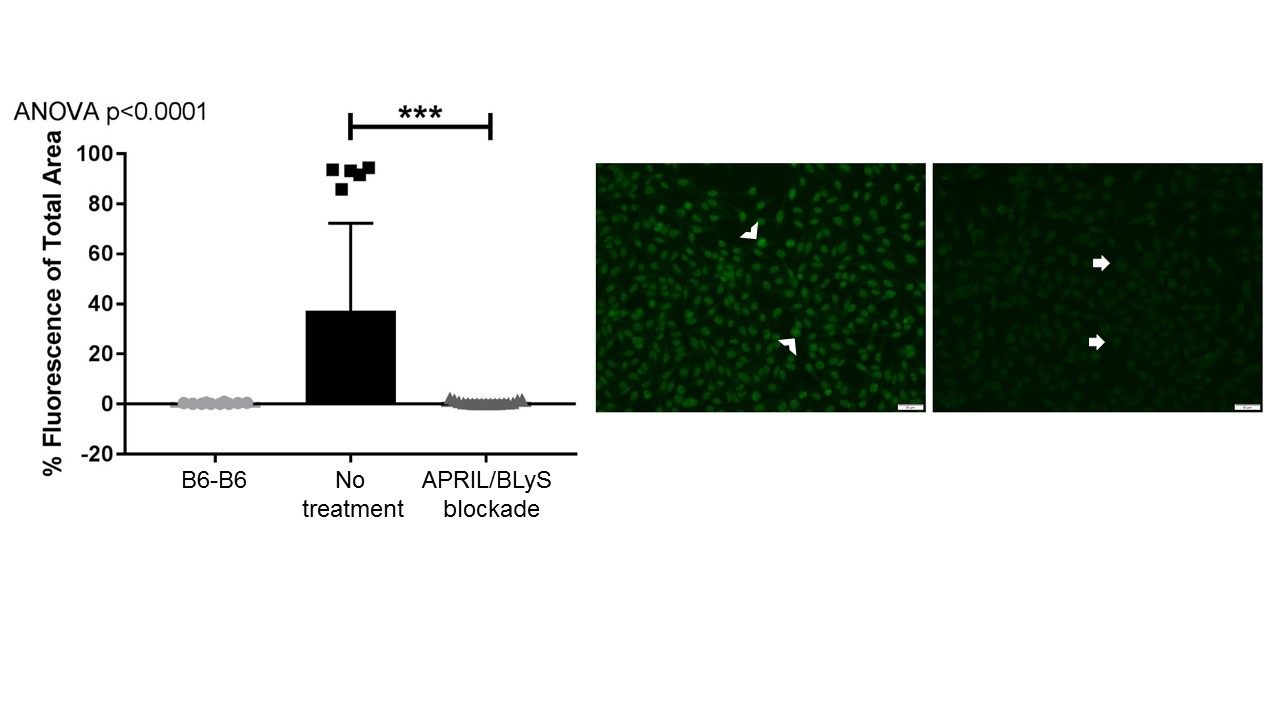Autoantibody Production Significantly Decreased with APRIL/BLyS Blockade in Murine Chronic Rejection Kidney Transplant Model
University of Wisconsin, Madison, WI
Meeting: 2019 American Transplant Congress
Abstract number: 169
Keywords: Highly-sensitized, Kidney transplantation, Mice, Minor histocompatibility antigens
Session Information
Session Name: Concurrent Session: B-cell / Antibody /Autoimmunity
Session Type: Concurrent Session
Date: Sunday, June 2, 2019
Session Time: 4:30pm-6:00pm
 Presentation Time: 5:06pm-5:18pm
Presentation Time: 5:06pm-5:18pm
Location: Room 310
*Purpose: Chronic antibody mediated rejection (cAMR) remains a significant barrier to achieving long-term graft survival in kidney transplantation. Alloantibody production from B lymphocytes and plasma cells is often the cause of long-term graft failure. APRIL (A proliferation-inducing ligand) and BLyS (B lymphocyte stimulator) are critical survival factors for B lymphocytes and plasma cells. Here we describe the results of APRIL/BLyS blockade in a cAMR rejection kidney transplant model in mice.
*Methods: c57/B6 mice underwent kidney transplantation with Bm12 kidneys (minor MHC mismatch), a well-described model for cAMR where animals cannot make donor specific antibody but rather make antinuclear antibody. Following transplantation, animals received TACI-Ig (to block APRIL and BLyS) or no treatment. Animals were continued on treatment until harvest 4 weeks following transplant. Serum was analyzed for circulating antinuclear autoantibodies using HEp-2 indirect immunofluorescence. Spleen and transplanted kidneys were analyzed via H&E.
*Results: Antinuclear autoantibody production was significantly decreased in APRIL/BLyS blockade treated animals (p<0.0001) (fig1). No significant difference in autoantibody production was found between syngeneic transplant control (B6 to B6) and APRIL/BLyS blockade treated animals (p=0.90). Additionally, disruption of splenic germinal center architecture was noted in the APRIL/BLyS blockade treated animals. Despite the significant decrease in autoantibody production and germinal center disruption, no significant difference in lymphocyte infiltration was noted in the transplanted kidney.
*Conclusions: APRIL/BLyS blockade resulted in a significant decrease of autoantibody production and disrupted splenic germinal center formation in a chronic kidney transplant model; however in this model no difference in kidney transplant pathology was seen, which may have to do with the absence of any T cell centric immunosuppression. Regardless, these findings suggest that APRIL/BLyS blockade may play a role in decreasing antibody formation long-term in kidney transplantation. Future investigations will use APRIL/BLyS blockade in conjunction with T lymphocyte depleting agents to determine its efficacy in chronic rejection.
Figure 1: APRIL/BLyS blockade resulted in significant reduction of antinuclear autoantibodies. Left- Graph represents significant reduction of fluorescence in APRIL/BLyS blockade treated animals. Middle- no treatment group, arrowheads indicate positive staining. Right- APRIL/BLyS blockade treated group, arrows indicate negative staining
To cite this abstract in AMA style:
Bath N, Ding X, Verhoven B, Reese S, Wilson N, Sukhwal A, III RRedfield. Autoantibody Production Significantly Decreased with APRIL/BLyS Blockade in Murine Chronic Rejection Kidney Transplant Model [abstract]. Am J Transplant. 2019; 19 (suppl 3). https://atcmeetingabstracts.com/abstract/autoantibody-production-significantly-decreased-with-april-blys-blockade-in-murine-chronic-rejection-kidney-transplant-model/. Accessed December 10, 2025.« Back to 2019 American Transplant Congress

